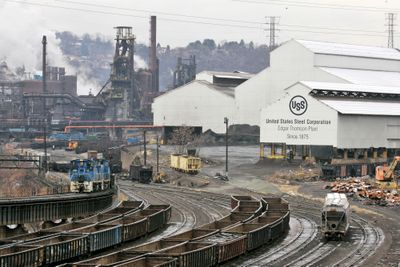Steel’s meltdown
Shortly after posting record profits, the industry faces layoffs, production cuts

PITTSBURGH – Just weeks after posting record profits, steel makers are facing a harsh new reality: dwindling orders, production cuts, layoffs. And tougher times lie ahead, analysts say.
The steel industry had been riding high earlier this year, as surging demand from China and other countries, coupled with soaring prices for materials used in steel making, produced the most lucrative market for the metal in more than 60 years.
The credit crisis and economic slowdown have undercut customers in key markets – construction, automobiles and industrial equipment – sending prices tumbling and prompting steel companies to slash production, scale back shipment forecasts, delay expansion and lay off workers.
Lower revenues and more layoffs loom in the months ahead, and production may not return to levels seen earlier this year for more than two years, according to some analysts.
“The downturn has been dramatic, both in the speed and the magnitude,” said Christopher Plummer, managing director of Metal Strategies Inc., a consulting firm in West Chester, Pa. “It’s quite concerning and alarming.”
John Anton, a steel economist with IHS Global Insight, said he expects U.S. steel production to fall next year, and that steel companies will be lucky to make about 65 percent as much as they did in 2008. Revenues could fall 35 to 40 percent, and pre-slowdown production levels may not return until 2011.
Layoffs and production cuts are inevitable, but “as long as (steel companies) saved some of the huge profits they made in 2008 … they should survive,” he said.
The U.S. steel industry has been particularly hard hit by a decline in the number of new houses being built after multiple years of excessive construction, Anton said. While little steel is used in new residences, they bring shopping centers, hospitals and schools – buildings made from larger amounts of the metal.
Demand suddenly began drying up in August. China’s expansion waned partly due to a drop in demand for Chinese goods, while North American and European construction tailed off. U.S. automakers reported plummeting sales and continued shifting toward smaller cars that require less steel. The dollar strengthened, dampening exports, and steel distributors liquidated their inventories.
The drop in demand has pulled down prices. Scrap steel, used by steel mills, recently slid to about $90 per gross ton after trading around $550 in July. The metal, from junked cars and other refuse, is a market indicator.
Meanwhile, hot-rolled sheet steel, used in autos, office furniture and appliances and considered the industry’s benchmark product, dropped to about $785 per ton a few weeks ago from $1,080 in July. In a very short period, steel went from its worst market since World War II, from 1998 to 2002, to its strongest, said Plummer, of Metal Strategies. “And now you can see we’re in a significant free-fall.”